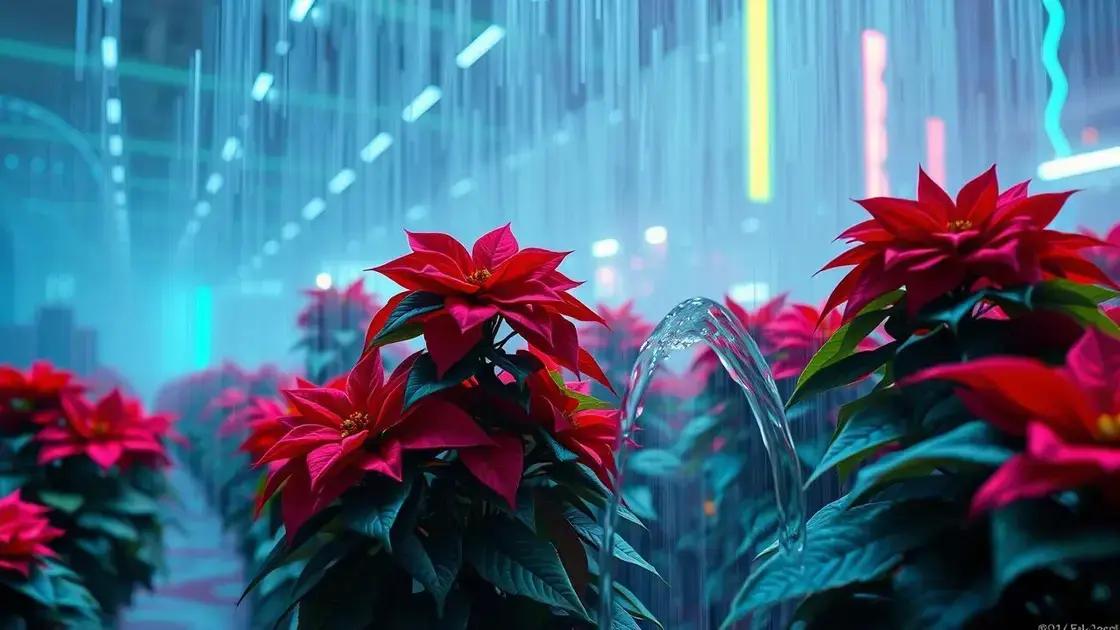How to Take Care of a Poinsettia Plant Year Round: 7 Essential Tips
How to take care of a poinsettia plant year round? Many wonder how to keep their plants vibrant and healthy long after the holiday season has ended. Discover simple yet effective tips that will not only enhance your poinsettia’s beauty but ensure it thrives throughout the year. Whether you’re new to gardening or a seasoned plant parent, these insights will help you appreciate and care for your poinsettia.
Table of Contents
ToggleUnderstanding the light requirements for poinsettias
Understanding the light requirements for poinsettias is crucial for how to take care of a poinsettia plant year round. These vibrant plants thrive when placed in the right lighting conditions, which can significantly influence their health and growth.
Key light conditions for poinsettias
- Indirect sunlight: Poinsettias prefer bright, indirect light. Place them near a window that receives filtered sunlight.
- Avoid direct sunlight: While they enjoy light, too much direct sunlight can scorch their leaves.
- Temperature impacts: Maintain a comfortable room temperature, ideally between 65°F and 70°F, along with proper light.
- Night duration: Poinsettias enjoy longer nights, especially during the blooming period, so aim for 14-16 hours of darkness.
Best locations for poinsettias
- Near east or north-facing windows, where they can benefit from gentle morning light.
- Avoid drafty windows or areas with sudden temperature changes that could stress the plant.
- Consider a grow light if natural light is insufficient, especially in winter months.
Effect of light on blooming
Proper lighting is key to encouraging blooming in poinsettia plants. To maintain their beautiful red and green foliage and prompt flowers during the holiday season, ensure they receive adequate light while managing darkness levels effectively.
Common questions about light requirements
- How much light do poinsettias need?
Poinsettias thrive in bright, indirect sunlight for at least 6 hours daily. - Can they survive in low light conditions?
While they can survive in lower light, this may result in weaker growth and fewer blooms. - Is artificial light sufficient?
Yes, using a grow light can supplement natural light during shorter days or darker months.
For more tips on optimizing light for various indoor plants, consider exploring indoor gardening techniques.
Essential watering techniques for healthy poinsettias

Essential watering techniques for healthy poinsettias are vital to how to take care of a poinsettia plant year round. Proper watering is one of the key factors that influence the overall health and vibrant appearance of these beautiful indoor plants.
Understanding watering needs
- Soil moisture: Poinsettias prefer their soil to be consistently moist, but not soggy. Check the top inch of the soil before watering.
- Water frequency: Typically, watering once a week is adequate, but this can vary depending on humidity and light levels.
- Water quality: Use room temperature water that is free from chlorine, as harsh chemicals can stress the plant.
Signs of overwatering and underwatering
- Signs of overwatering:
- Yellowing leaves that fall off the plant.
- Mushy stems or a foul odor from the soil.
- Signs of underwatering:
- Wilting leaves that feel dry to the touch.
- Crispy leaf edges that turn brown.
Best watering practices
Here are some effective watering techniques to ensure your poinsettias remain healthy:
- Water thoroughly until it drains out of the bottom of the pot.
- Use a pot with drainage holes to prevent water accumulation.
- Adjust frequency based on the season; plants may require less water in winter.
Common questions about watering poinsettias
- How often should I water my poinsettia?
Typically, once a week, ensuring the soil dries slightly in between. - Can I mist my poinsettia?
Misting can help increase humidity but should not replace proper watering. - What should I do if I suspect overwatering?
Allow the soil to dry out a bit before watering again and check the roots for rot.
For more insights on maintaining healthy plants, consider exploring indoor gardening techniques.
Year-round fertilizing tips for thriving poinsettias
Year-round fertilizing tips for thriving poinsettias are essential to how to take care of a poinsettia plant year round. Proper nutrition is key to maintaining vibrant foliage and encouraging beautiful blooms.
Understanding the nutrient needs
- Balanced fertilizer: Use a balanced, water-soluble fertilizer with equal parts nitrogen, phosphorus, and potassium (N-P-K).
- Frequency: Fertilize your poinsettias every 4-6 weeks during the growing season (spring through summer).
- Type of fertilizer: Choose a fertilizer designed for houseplants, as these typically have the right nutrient profile.
Application tips for fertilizing
Follow these steps to effectively fertilize your poinsettias:
- Mix the fertilizer with water according to the package instructions.
- Water the plant with this mixture, ensuring that the soil is evenly moistened.
- Avoid fertilizing newly repotted plants until they have settled in.
- During winter dormancy, reduce or skip fertilizing altogether since growth slows down.
Signs your poinsettia needs fertilization
Look for these indicators that your plant may need more nutrients:
- Yellowing leaves could indicate a nitrogen deficiency.
- Weak or leggy growth suggests insufficient light or nutrients.
- Pale foliage indicates a lack of essential nutrients.
Common questions about fertilizing poinsettias
- What type of fertilizer should I use?
A balanced, water-soluble fertilizer is ideal for poinsettias. - How often should I fertilize?
Every 4-6 weeks during the growing season, less frequently in winter. - Can I over-fertilize my poinsettia?
Yes, excessive fertilization can harm the plant; always follow recommended dosages.
For additional tips on nurturing your plants, consider exploring indoor gardening techniques.
In conclusion
Taking care of poinsettias year-round requires attention to various aspects such as light, watering, and fertilizing. By implementing the techniques discussed, you’ll create an environment where your poinsettias can thrive and bloom beautifully. Remember to monitor their needs, and adjust care practices as necessary to maintain their health throughout the seasons. For further insights and tips on enhancing your indoor garden, consider exploring additional resources to cultivate your green thumb.

